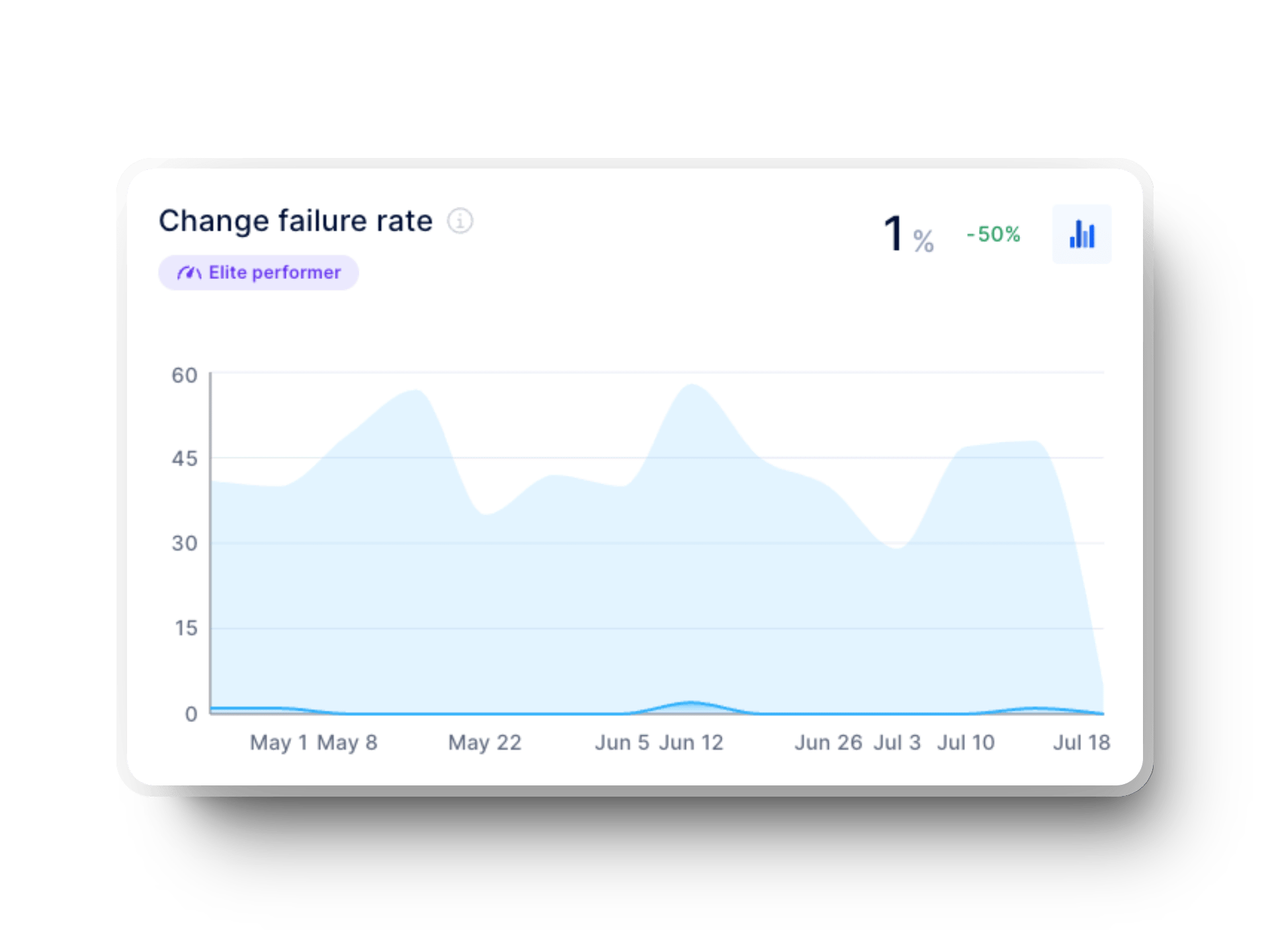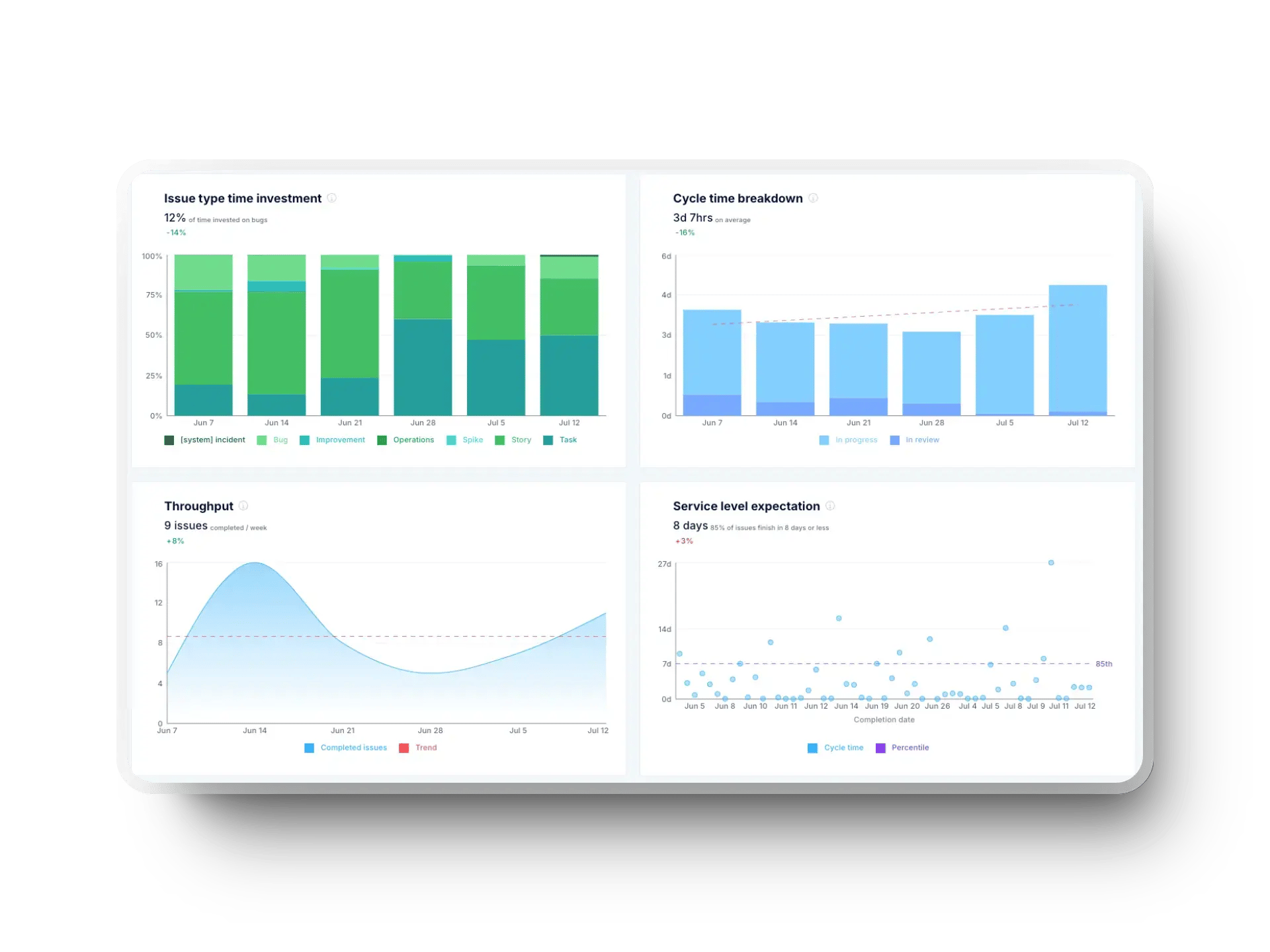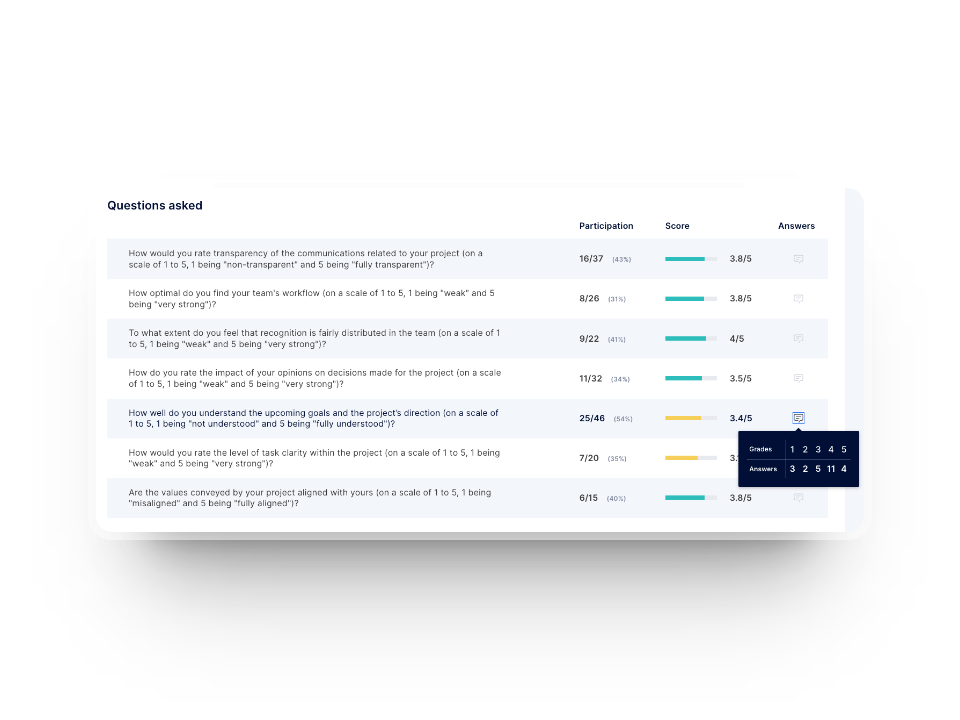At Axify, we know that bottlenecks, inefficient workflows, and constant context switching are daily frustrations for developers.
The State of Developer Productivity shows that most developers lose 5 to 15 hours per week on unproductive tasks like searching for data or dealing with slow code reviews.
But this isn’t just a productivity issue.
It affects the developer experience, leading to burnout and slower delivery times.
And since time-to-market matters significantly in a competitive industry, you must improve DevEx standards to avoid missed opportunities.
In this article, we’ll explore how tracking the right metrics and leveraging tools like Axify can enhance developer experience and empower your team to deliver faster, higher-quality results.
Let’s begin.
What is Developer Experience?
Developer experience refers to how developers perceive their interaction with tools, processes, and environments during software development.
Remember: This experience isn't limited to the tools developers use. It encompasses the entire infrastructure for software development, including integrated development environments and code reviews.
Pro tip: Use Axify’s Well-Being Tracker to monitor key metrics in your development team’s satisfaction, such as stress, psychological safety, motivation, inclusion, and alignment.
User Experience (UX) vs Developer Experience (DX)
Both user experience and developer experience focus on ease of interaction. However, their target users differ.
- Customers: UX centers on creating smooth, intuitive interactions for customers. These interactions directly impact the product’s usability and customer satisfaction.
- Developers: DX ensures that the developer team works with minimal friction, which is crucial for building high-quality software efficiently.
UX and DX are both important in product development.
- Bad DevEx slows down development and reduces code quality.
- This leads to a poor front-end experience that drives customers away.
That’s why ensuring an excellent DX is the cornerstone of your business goals.
That brings us to the next point.
The Importance of Developer Experience
Developer experience matters for your entire software company. Here's why.
Better Developer Productivity
- Reduced onboarding time: New developers can start contributing sooner by streamlining processes and providing comprehensive documentation. This lowers their cognitive load and accelerates their integration into the team.
- Faster development cycles: Offer efficient tools and create optimized development workflows for developers. This will help them complete tasks faster, speeding up the development cycle.
- Lower error rates: Intuitive developer tools and environments minimize confusion and reduce the chances of mistakes, leading to more reliable, high-quality code and fewer bugs.
Pro tip: Pair programming is an excellent way to increase productivity, code quality, and motivation. 66% of developers list fewer bugs as the main benefit of pair programming. That’s important because the longer bugs stay in the code, the more difficult they are to detect and remove. That’s a frustrating element for developers that affects their overall morale.
Better Business Outcomes
- Time-to-market: A smoother development process translates to quicker product launches. The point is to cut down the time spent on tedious processes and get features to users faster, which you want in a competitive context.
- Product quality: A better DX leads to higher-quality software applications because developers are more engaged and less burdened by unnecessary complexities or bottlenecks. This also results in fewer post-launch issues, saving time and resources.
- Developer retention and satisfaction: Investing in a positive developer experience boosts developer satisfaction and retention. Poor DevEx makes developers more likely to leave, increasing your turnover costs.
Competitive Advantage
Companies with a strong focus on DX set themselves apart in the market. A DevEx-forward organization attracts talented developers and builds better products faster.
Besides, 63% of developers consider job satisfaction a top factor in deciding whether to keep their current job.
Having good developers allows you to respond quickly to market changes and customer needs, positioning your company as a leader in innovation.
Pro tip: Not sure exactly where you stand regarding team processes and habits? Take this free Team Maturity Assessment to get a precise score and actionable recommendations for improvements you can make starting today.
Key Elements of a Great Developer Experience
Now you know what developer experience is and why it matters. Understanding its elements is also essential to recognizing where improvements are needed.
1. Intuitive and Efficient Tools
A strong developer experience begins with intuitive, efficient tools that reduce cognitive load and speed up development cycles.
Your Dev team is likely increasingly frustrated with spending time on duplicate work or searching for context across disconnected tools. This leads to wasted time and productivity losses.
According to the 2024 State of Developer Experience Report, 90% of developers need improved productivity to be prioritized.
Pro tip: Offer Command-Line Interfaces (CLIs) and highly integrated Integrated Development Environments (IDEs) to eliminate bottlenecks and help developers focus on building.
2. Less Idle Time
26% of developers say that gathering project context and waiting for approvals are the most significant factors affecting productivity.
To maximize developer productivity, you can overlap phases of the software development lifecycle (SDLC), such as testing while coding. Leverage continuous integration and automated testing so developers can test code as they write it in real-time. This approach reduces bottlenecks caused by waiting for separate testing phases and approvals.
Pro tip: Axify offers a single source of truth for engineering metrics through an intuitive dashboard. This gives your team clear visibility and reduces the need for constant back-and-forth communication, allowing you to meet your business goals more efficiently.
 3. Comprehensive and Clear Documentation
3. Comprehensive and Clear Documentation
Clear and accessible developer documentation can significantly reduce onboarding time and boost developer satisfaction.
72% of developers admit that new hires need over a month to submit their first three PRs. That’s a lot.
To solve this, offer comprehensive Getting Started Guides, detailed API documentation, and real-world code samples. That’s how you:
- Reduce ramp-up time.
- Minimize friction for developers.
- Allow people to contribute faster and with fewer mistakes.
This ultimately enhances team efficiency and product quality, improving business outcomes.
4. Well-designed APIs
Well-designed APIs are fundamental to a positive DX. Whether you're using RESTful APIs or more flexible paradigms like GraphQL, the goal is to make the API easy to understand and quick to integrate.
Companies that offer easy integration points through SDKs and libraries see faster implementation times, shorter development cycles, and more developer happiness.
Besides, API usability and clear documentation improve the software quality delivered to end users.
5. Easy Integration and Compatibility
Cross-platform support and seamless integration are essential for modern development teams, especially those with complex tech stacks.
Handling diverse tools and platforms is not easy, though. Recent surveys show that 34% of engineering organizations didn’t implement AI because they lacked know-how.
However, your developers need robust SDKs, libraries, and compatibility across operating systems. This allows them to focus on building rather than troubleshooting integration issues.
Pro tip: Pre-built components and well-designed developer portals can help you spend more time on value-adding tasks.
Developer Experience Metrics
Tracking the right metrics is essential to improving developer productivity and experience. At Axify, we focus on both traditional engineering metrics like cycle time and flow metrics and metrics specifically designed to measure developer satisfaction and positive DevEx. These metrics offer deep insights into your engineering team’s performance and help you identify bottlenecks hindering development.
1. Cycle Time
Cycle time measures the time it takes for a task to move from start (i.e., task assignment) to finish. Monitoring this metric helps you find bottlenecks that cause delays.
As a result, you can minimize backlog accumulation, reduce friction in your team’s delivery process, and decrease employee frustration.
2. WIP (Work in Progress)
65% of developers experienced burnout, which can be caused by an overwhelming number of tasks. That’s why you should manage task loads efficiently
Placing WIP limits prevents multitasking and reduces cognitive load. The point is for developers to focus on fewer items simultaneously, reducing the likelihood of errors and inefficiencies.
%20metric%20in%20Axify%20for%20software%20engineering%20teams.webp?width=1260&height=1134&name=Work%20in%20progress%20(WIP)%20metric%20in%20Axify%20for%20software%20engineering%20teams.webp)
3. Deployment Frequency
Tracking flow metrics like deployment frequency offers deeper insights into your development workflows. Following this metric helps you streamline testing, deploying, providing feedback, and rolling back problems.
That’s because deployment frequency, assessed with other flow metrics, highlights potential bottlenecks you can solve to improve efficiency.
It improves your team’s workflow, decreasing frustration and dissatisfaction.

4. Code Quality and Bug Resolution Times
Maintaining high code quality is essential for delivering a robust product and for avoiding tedious troubleshooting.
Finding bugs later in the code is linked to increased workload and frustration.
Bug resolution times are crucial for maintaining a smooth workflow. Teams that address bugs quickly improve their software’s reliability and reduce downtime. Fast feedback cycles directly impact developer satisfaction because they minimize the frustration caused by unresolved issues. The result is making your team more efficient in the long run.
Pro tip: Axify tracks essential metrics like issue-type time investment, which helps teams identify where their resources are focused and adjust priorities accordingly. Additionally, key DORA metrics such as change failure rate and deployment recovery time ensure teams address quality issues promptly, leading to more reliable software and reduced downtime.

5. Unique Developer Experience Metrics in Axify
41% of engineering executives use the same tools to measure developer productivity and experience, even if these are not the same.
However, although there's a direct correlation between the productivity metrics we outlined above, they can’t show the full picture in terms of DevEx.
That’s where Axify’s Well-Being Tracker comes in.
After two weeks of gathering data, Axify begins to populate your graphs with valuable insights into key metrics like resilience, motivation, inclusion, psychological safety, and alignment.
This data enables you to spot early signs of tension, stress, or other problems within your team quickly, giving you the opportunity to respond swiftly and proactively.
With Axify, you can promote a safe, productive environment through open communication and trust.
Future Trends and Challenges in Developer Experience
To create a positive developer experience, consider the following trends and challenges.
Trends
- Predictive coding and intelligent assistants: These tools leverage AI to suggest code snippets, automate repetitive tasks, and identify bugs before deployment. 61% of engineering leaders reported using AI tools to enhance developer productivity, with 81% saying AI improved code quality. As these tools become more sophisticated, they will continue to streamline the software development process, reducing developers' cognitive load and enabling faster, more accurate coding.
- Cloud-based development: Positive DevEx is further enhanced when teams have seamless access to resources, regardless of location. And cloud-based development allows you to access development environments from anywhere. This trend simplifies the setup of integrated development environments (IDEs) and reduces time spent configuring local machines. Cloud-based platforms also offer more scalable solutions, allowing developers to adapt their workflows to the growing demands of the business.
Challenges
- Simplifying without losing focus: A key challenge for DevOps leaders is simplifying development processes for their teams without oversimplifying the process needed to meet business goals. Tools like Axify help because they focus on essential metrics. Therefore, DevOps leaders have a clear view of their team’s progress, which leads to better decision-making for team alignment and success.
- Adapting to new trends and tools: New tools like intelligent assistants and AI-driven coding platforms will keep emerging. However, the learning curve and pressure to adapt will also increase. Integrating these new technologies will be even more time-consuming and costly if you have complex tech stacks. You must stay agile, continually evolve DevOps practices, and implement continuous learning.
- Budget and time limitations: Implementing cutting-edge tools and processes is expensive, and engineering teams often face budget constraints. On top of that, there’s the pressure of delivering within tight timelines. The challenge lies in making strategic investments and setting priorities to improve developer satisfaction while aligning with business outcomes.
Leverage Axify to Enhance DevEx
Axify can help you maximize these DevEx trends and solve the challenges above. Here’s how.
1. Axify Helps You Identify Bottlenecks Faster
Axify offers comprehensive insights into your development processes, making it easier to spot inefficiencies. Instead of focusing solely on cycle time or lead time for changes, you can also track metrics like flow efficiency to see how work moves through each stage or work in progress (WIP) to identify where your team might be taking on too much.
These metrics help you reduce bottlenecks, optimize team capacity, and ensure a more streamlined workflow, keeping your projects on track and your developers happier.

2. Improve Team Collaboration with Axify
Collaboration is critical to delivering high-quality software on time. Axify’s Daily Digest helps you find and focus on your priorities and remove distractions. This dashboard also highlights high-risk items and bottlenecks.

All this helps you organize your daily standup rituals, maximizing the time spent in meetings and assigning responsibilities correctly. As a result, everyone will be on the same page, working better together.
Pro tip: Knowing your priorities, risks, and tasks eliminates unplanned, unnecessary meetings. This helps your team maintain a flow state more easily. According to the Atlassian State of Developer Experience Report, chunks of 90-120 minutes of uninterrupted work are a good way to improve DevEx.
3. Streamline Your Workload
With Axify’s Value Stream Mapping (VSM) and historical data, you gain insights into where work can be simplified and optimized. The platform offers tailored recommendations that help you focus on critical areas, reducing your team's cognitive load.
This ensures that developers spend less time on tedious tasks and more time building features, leading to a smoother, more efficient workflow.

4. Accelerate Recovery
Axify tracks Failed Deployment Recovery Time, formerly known as Mean Time to Recovery and Time to Restore Service. This, combined with other DORA and flow metrics, gives you critical insights into how fast your team recovers from issues.
%20in%20axify%20for%20software%20development%20teams.webp?width=1920&height=1440&name=time%20to%20restore%20service%20(dora%20metrics)%20in%20axify%20for%20software%20development%20teams.webp)
Improving recovery times is essential to reduce downtime and enhance DevEx because your engineering team will focus on high-impact tasks. Ultimately, the result is not just their satisfaction but a more stable product for your customers and business success.
5. Set Your Goals Correctly
Setting your goals from the start orients everyone toward the same purpose. That’s how you avoid unnecessary work and bottlenecks.
Axify has two features that help you set your goals well.
First, the Objectives Tracking feature allows you to set corporate objectives and measure your team's progress against them. By increasing clarity and collaboration, you minimize frustration and improve DevEx.
![]()
Secondly, the software delivery forecasting tool uses historical data to anticipate problems and risks and predict timelines. You’ll get visual projections of different scenarios that you can then use to set your goals and limit WIP. Again, this aligns your team’s efforts and improves DevEx.
![]()
If you’re curious how all that looks in practice, try Axify today with a 14-day free trial.






.png?width=60&name=About%20Us%20-%20Axify%20(2).png)


